Flat-faced, squish-nosed, smoosh-faced… many names are used for dogs with short side profiles. But, while those mutt monikers are cute and descriptive, the technical term for these short headed pups is brachycephalic dogs.
Even then, it’s not so simple, as the term brachycephalic breed has a more complex definition than simply a dog with a shorter face.
Below, we’ll explain what brachycephalic means, list some of the breeds that usually have the condition, and share some breeds that are often listed as brachycephalic yet don’t meet the criteria.
Brachycephalic Dog Breeds: Key Takeaways
- Brachycephalic dogs have broad, short skulls. The word itself is easy to break down, with “brachy-” meaning “short” and “cephalic” meaning “relating to or of the head.”
- Truly brachycephalic dogs score 80 or above on something called the cephalic index. Calculating a dog’s cephalic index is easy: Multiply the width of the head by 100, then divide that sum by the length of the head.
- Brachycephalic dogs are prone to numerous health issues. Brachycephalic canines are susceptible to serious problems, including breathing difficulties, eye disorders, and recurrent ear infections due to their extreme skull shape.
What Does Brachycephalic Mean?

Brachycephalic is a term related to the size of a dog’s head compared to the muzzle, as brachy- means “short,” and cephalic means “relating to or of the head.”
Therefore, a brachycephalic dog is, in essence, a short-headed dog.
Example: With a short and broad head, pugs are often brachycephalic.
Unfortunately, it’s more complicated than just noting a dog’s shortened face when determining if he’s brachycephalic. Dogs need to score over 80 in the cephalic index to be considered truly brachycephalic, which we’ll get into more below.
Other terms related to skull shape are mesocephalic and dolichocephalic. Mesocephalic means “middle-headed,” while dolichocephalic means “long-headed.”
A mesocephalic dog’s skull is an intermediate size between short and long. In contrast, a dolichocephalic dog typically has a longer, more pronounced skull shape. Most dog breeds fall into the dolichocephalic range.
What Is a Cephalic Index?

A cephalic index is calculated by multiplying the width of a dog’s head by 100, then dividing the result by the head’s length.
Example: A random bulldog’s head measures 14.7 inches wide and 14.2 inches long.
Multiple 14.7 (the width) by 100, and you get 1470. Divide 1470 by 14.2 (the length.) The answer rounds to 103. This is well above 80, making this dog brachycephalic.
Brachycephalic is used to describe a dog with a cephalic index higher than 80.
A mesocephalic dog has a cephalic score between 75 and 80, while a dog under 75 is considered dolichocephalic.
Why Should I Care If My Dog’s Brachycephalic?
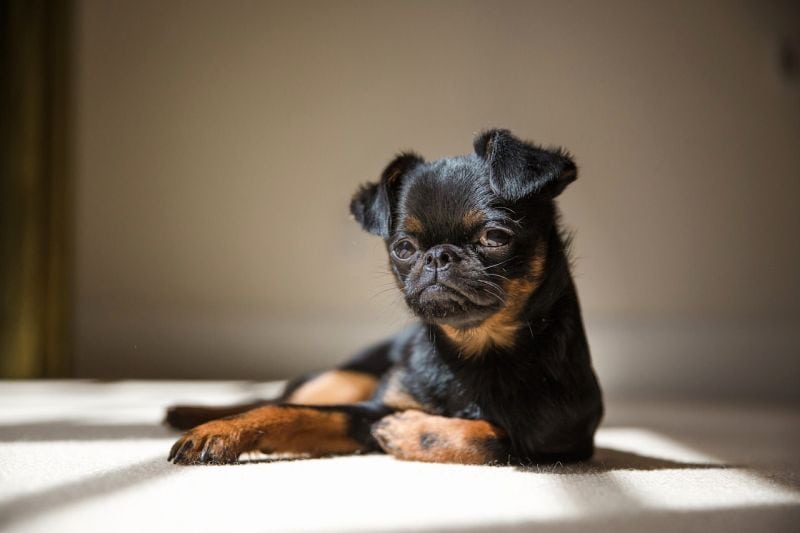
Brachycephalic dog breeds are more in demand than ever, with the pug, French bulldog, and English bulldog exploding in popularity over recent years.
Countless designer breeds are also popping up, which use these and other brachycephalic breeds as foundation stock. This leads to more extreme skull and body shapes, which in turn leads to increased impacts on canine health. These include “exotic” bullies, puggles, and beabulls.
The primary concern with shortened skulls is brachycephalic airway obstruction syndrome (also called BAOS) – a term that describes a series of issues that affect a dog’s breathing.

A brachycephalic head has less space for vital anatomical structures, including nasal passages and tracheas, which can lead to unnatural narrowing, affecting breathing.
Other complications seen in dogs with BAOS include an elongated palate and oversized turbinates.
While crossbreeds of traditionally brachycephalic breeds may sometimes avoid the high cephalic index of their full-blooded friends, this isn’t always the case.
In response, many veterinarians and animal welfare organizations are speaking out against the harm of breeding for disproportionate body shapes, including the Humane Society Veterinary Medical Association.
Living with a brachycephalic dog isn’t like having a run-of-the-mill retriever. The head shape affects everything from your dog’s daily routine to your financial stability, with serious health challenges and care needs requiring special attention.
Being informed about the risk of valuing cuteness over a dog’s health empowers you to skip unethical breeders that stray from breed standards and find a pup that will live a long, healthy life.
15 Brachycephalic Dog Breeds
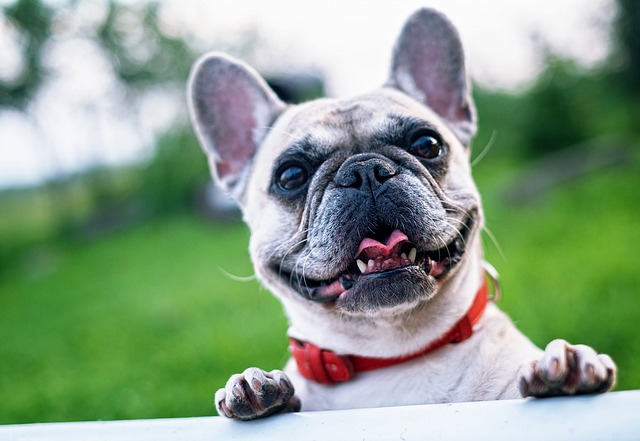
Now that we know what brachycephalic dogs are, let’s discern which breeds do and do not meet the definition.
Some breeds have the occasional brachycephalic canine among their members, but truly brachycephalic breeds have the majority scoring above 80 on the cephalic index.
Correctly identifying which pups fall in this range helps you better understand your current dog’s needs or make an educated decision when seeking a dog in the future.
Several dog breeds almost always fall within the brachycephalic range, including:
1. Affenpinscher
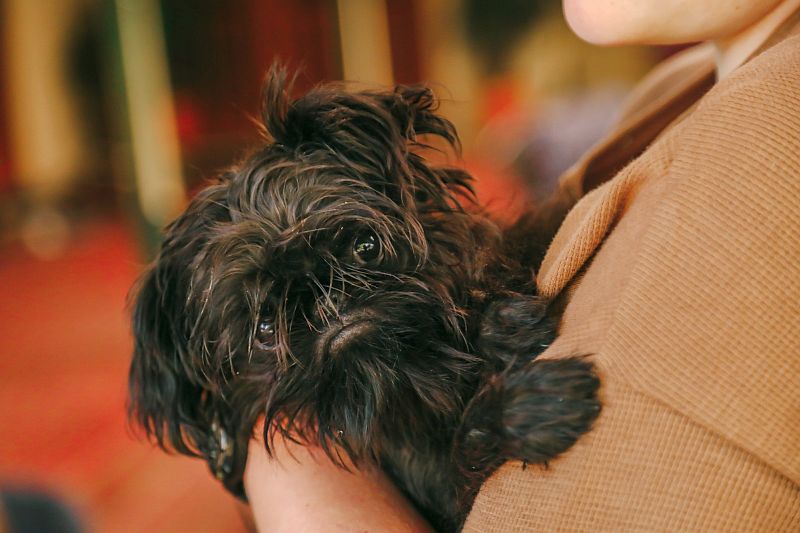
Adored for his grumpy monkey expression, the Affenpinscher or “Affen” is a lesser-known brachycephalic barker from Germany.
Unfortunately, this scrunch-faced expression also leaves him prone to overheating. He’s also at risk of luxating patella, heart issues, and vision disorders, making finding a good breeder essential.
2. Bulldog
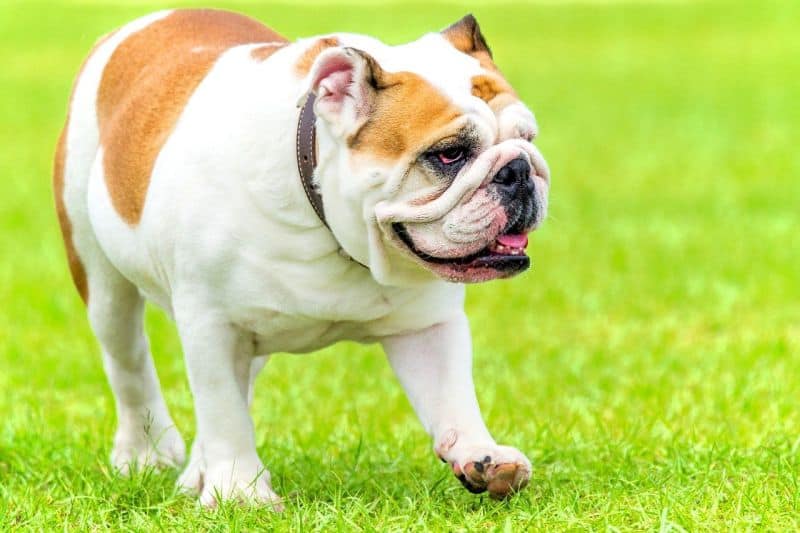
This tank-like tater tot is one of the best-known brachycephalic breeds, with most individuals meeting the criteria. He’s not suited for warmer weather or heavy exercise, so you’ll need to let him hang out indoors when it is hot.
Also, you’ll need to watch for skin issues and toots, as he’s among the gassiest dog breeds. Fortunately, you can help prevent these issues by selecting one of the best bulldog dog foods.
3. Brussels Griffon

The Brussel Griffon’s trademark pout comes with the caveat of making him a brachycephalic dog breed. This can clash with his love of fun and exercise, but indoor play and a walk when weather-appropriate can meet his needs just fine.
The Brussel Griffon is one of the most affectionate dog breeds, and pet parents delight in his loyalty and natural curiosity.
4. Bullmastiff
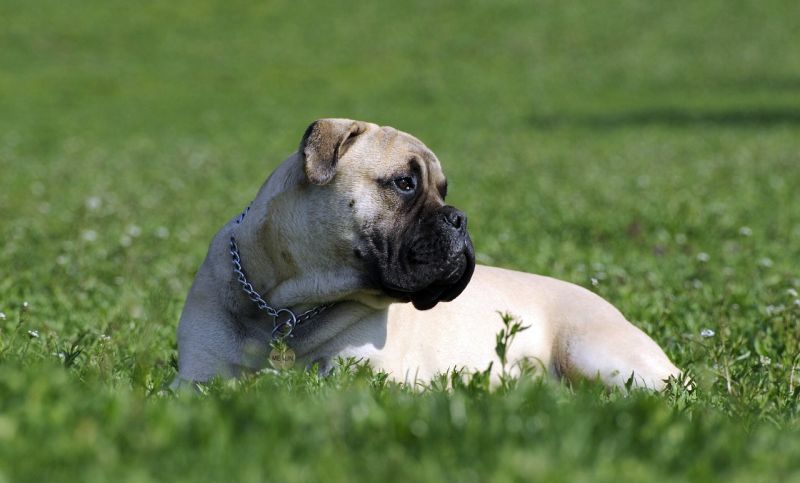
Unfortunately, the bullmastiff’s mighty head is on the short side, leading to a fair share of breed members being brachycephalic. Avoid prolonged exposure to hot weather and pay close attention to his diet, as he can quickly pack on pounds, which can worsen breathing issues.
Loyalty is the bullmastiff’s calling card, along with bravery, making him an excellent watchdog.
5. Boston Terrier
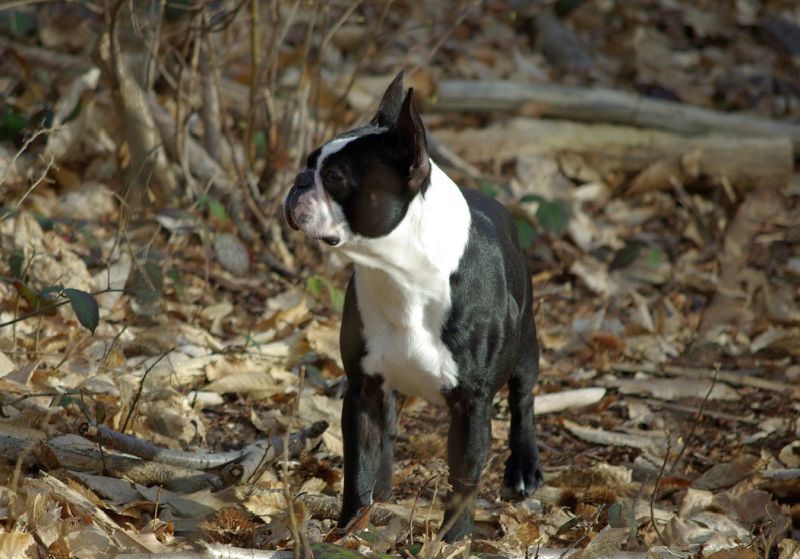
The Boston’s bulldog roots are obvious, but this also means most members of the breed fall into the brachycephalic category like their canine cousins.
Care with exercise and food choice are crucial, as are regular checkups, as the breed’s peculiar skull shape leaves him at risk of eye issues, too. He’s the perfect compact pup for big dog lovers and is easily one of the best dog breeds for city living.
6. Chow Chow
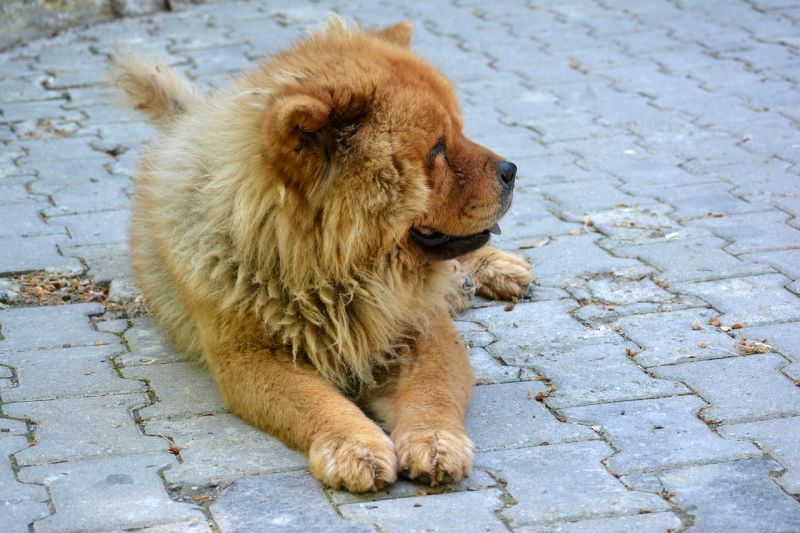
This lion-like canine’s large head is relatively short under all that hair, frequently earning him a score above 80 on the cephalic index. Add in his mountain of fuzz, and it’s a recipe for trouble in warm weather.
Beginner dog owners shouldn’t start with a chow, as this powerful pup is headstrong and requires considerable training and socialization.
7. Dogue de Bordeaux

The Dogue’s unique facial features lead to most of the breed landing well within the brachycephalic range.
He’s very sensitive to heat and exercise, which can lead to your pup gaining extra weight if you’re not careful. Low-impact, daily exercise, such as slow, leisurely walks when weather permitting, is vital in keeping him trim.
8. English Toy Spaniel
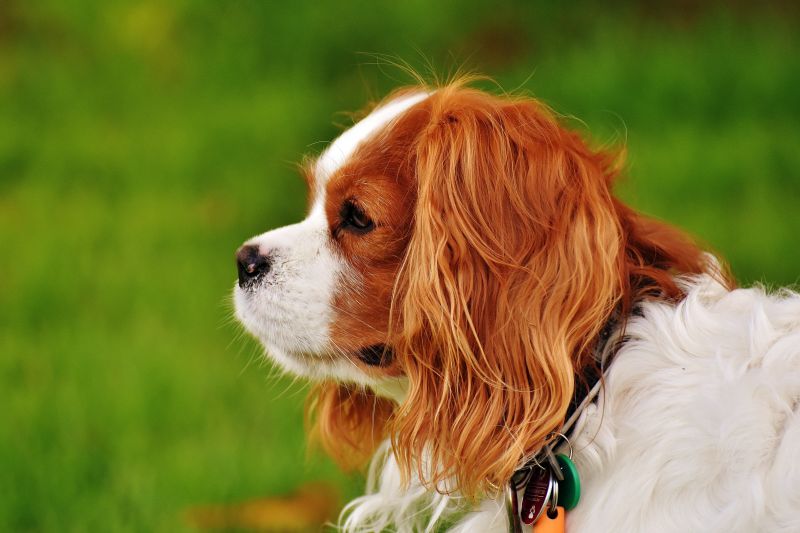
The English toy spaniel’s unique look is undoubtedly eye-catching, but it often earns him a spot in the brachycephalic category.
He’s predisposed to the usual brachycephalic issues, including dental problems, ear infections, and eye injuries. Keep up on toothbrushing, ear cleaning, and eye checks to maintain his bits and pieces.
9. French Bulldog
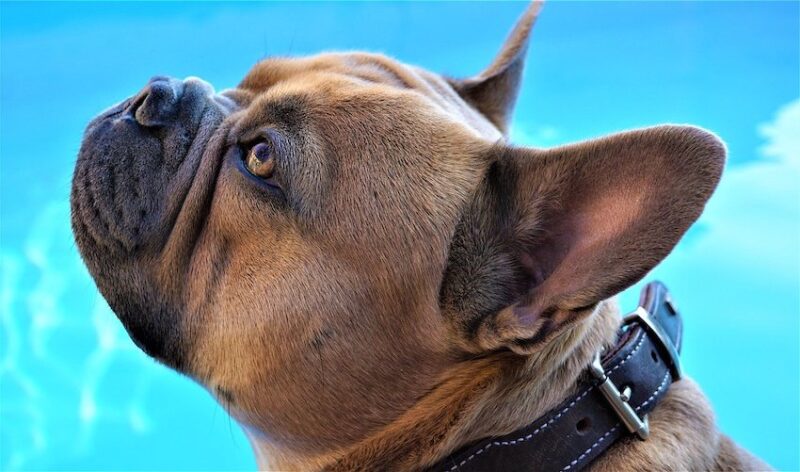
The Frenchie is one of the calmest dog breeds, but his laundry list of medical ailments may raise your blood pressure (and vet bills.) For example, he is incredibly sensitive to anesthesia, exercise, and temperature extremes.
Health hiccups aside, affection and Frenchies go hand-in-hand, as this sweet-natured snuggle bug is always down for belly rubs and pats. Just be sure that you work closely with your vet and pick a good food for French bulldogs.
10. Japanese Chin
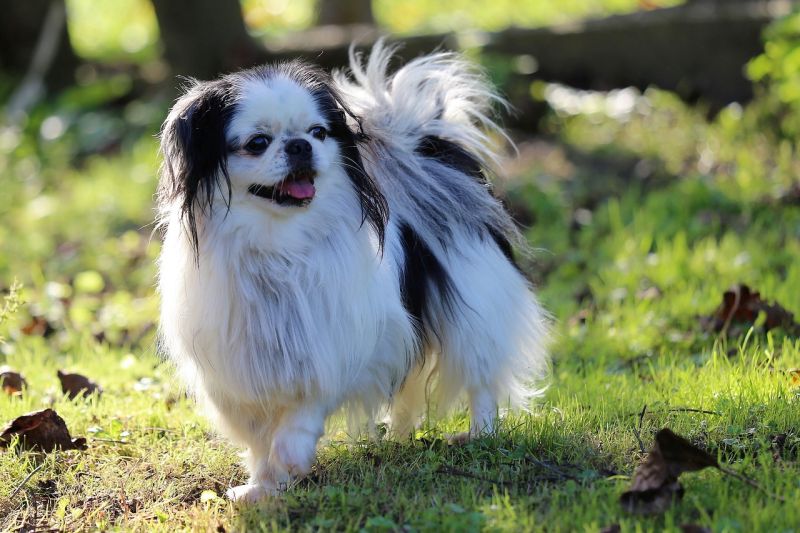
A bulbous forehead and short snout give away the Japanese Chin as brachycephalic from a mile away.
His extreme head shape leaves him at risk of respiratory and eye problems, and he can also suffer from heart murmurs and kneecap slippage.
11. Lhasa Apso
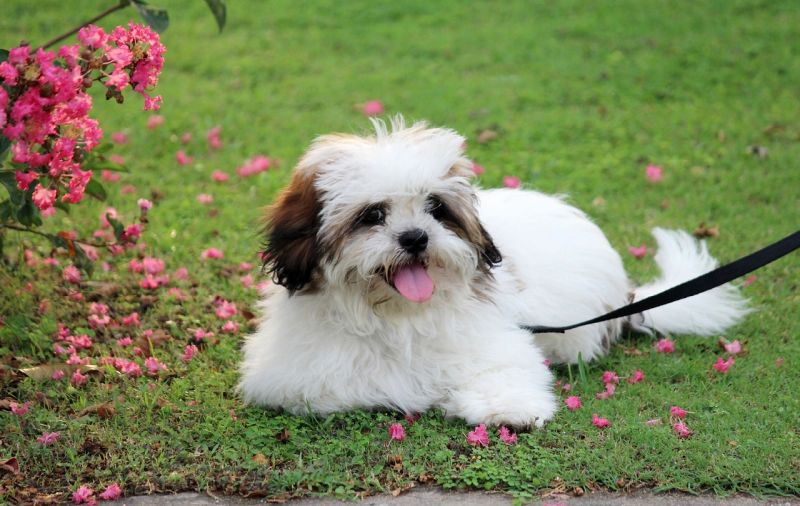
The Lhasa has a short skull like many dogs from his region. Some fall into the mesocephalic range and don’t have breathing issues, but many others are brachycephalic, requiring special handling. Eye issues are also a concern.
12. Pekingese
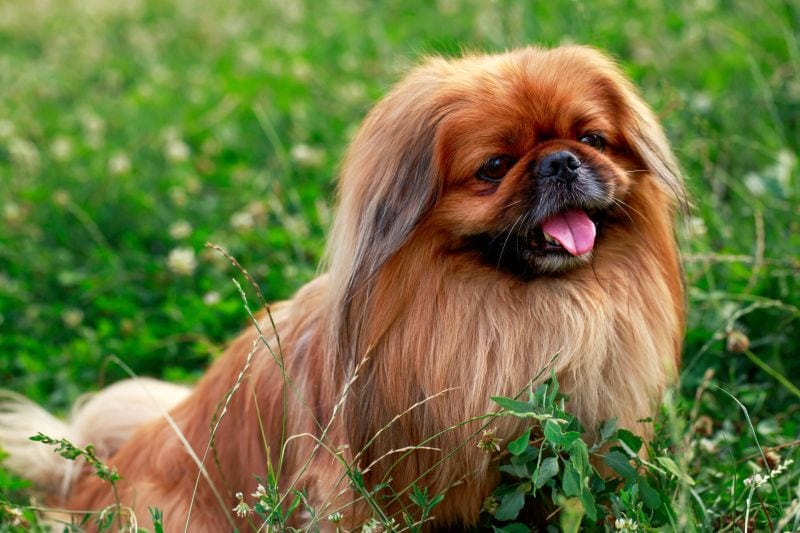
The Pekingese has the classic physical markers of being brachycephalic with his incredibly short muzzle and shallow eye sockets. He’s also susceptible to other serious health problems, including eyeball prolapse, heart issues, and intervertebral disc disease.
His coat requires a lot of grooming if left long, including daily brushing, especially around the ears.
13. Pug
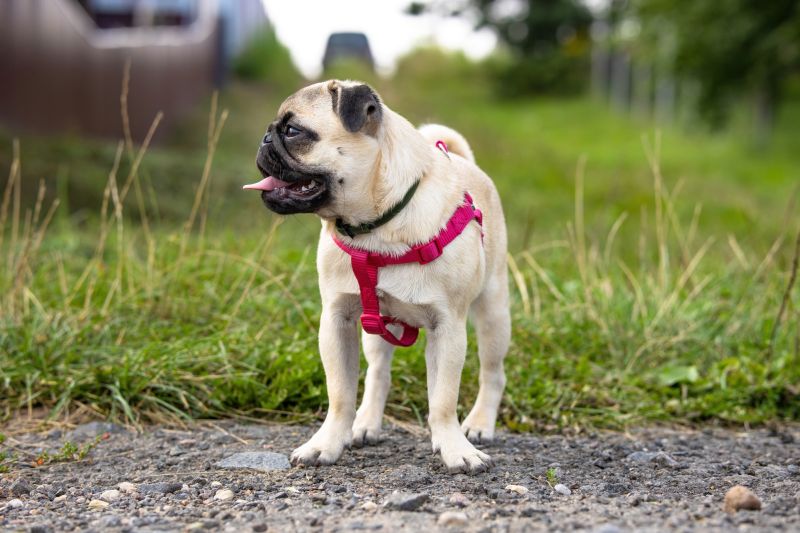
A May 2022 study by the Royal Veterinary College found that pugs are 54 percent more likely to suffer from BAOS than other breeds. Pugs are also at risk of eye problems, pug dog encephalitis, and skin infections.
Health issues aside, pugs are one of the most clownish breeds.
Read Now: The Best Dog Foods for Pugs!
14. Shih Tzu
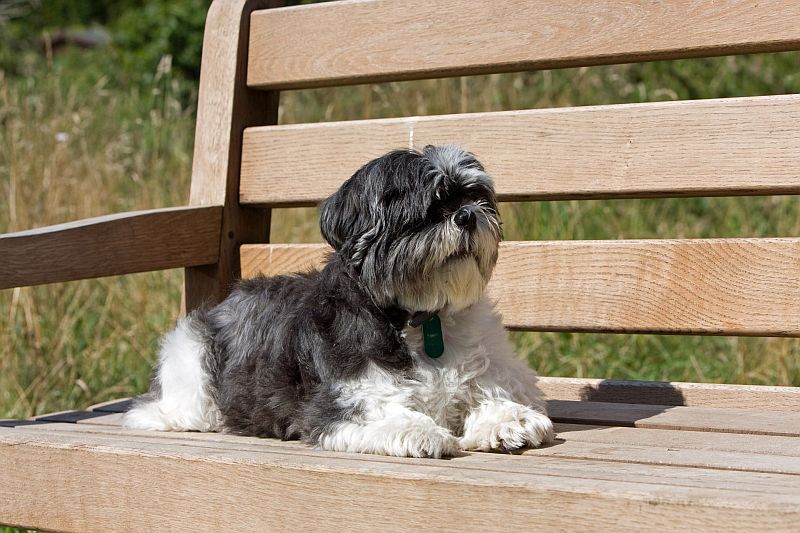
Many shiz tzus are categorized as brachycephalic and suffer from common ailments seen with the build, including eye problems. His short face can be especially dangerous in warmer weather combined with his long coat.
This breed is also susceptible to joint issues like patellar luxation and hip dysplasia. But picking a good food for your shih tzu can help address or prevent some of the pain associated with these joint problemos.
15. Tibetan Spaniel
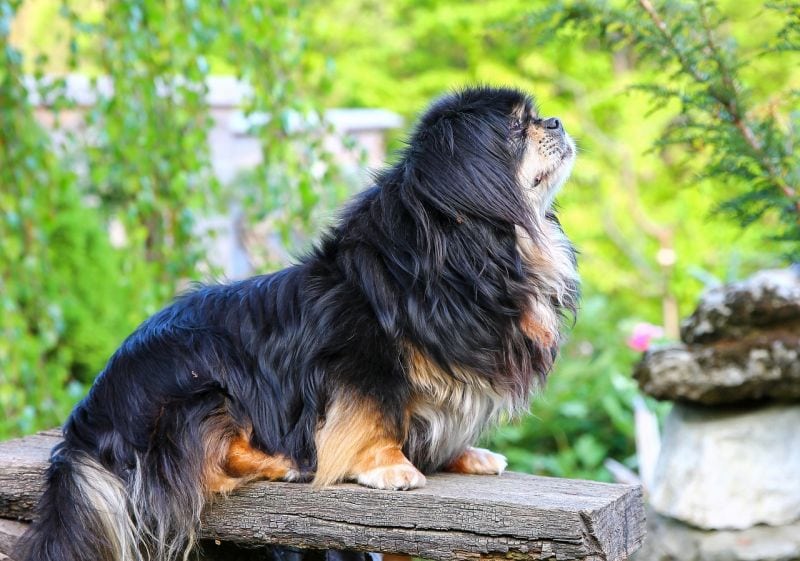
The lion’s share of this ancient breed falls into the brachycephalic domain. This can make exercising this spirited sprite tricky in warm weather, so invest in fun indoor games to keep him busy.
Watch for ocular issues, too, as he’s prone to a host of problems due to his bug-eyed appearance.
11 Dog Breeds in Which Some Individuals Are Brachycephalic, While Others Are Not
Some breeds are assumed to be brachycephalic, but not all doggos in their ranks have a cephalic score above 80, which generally leaves them in the mesocephalic range (and a few outliers may even be dolichocephalic).
Check out these occasionally brachycephalic barkers.
1. Boxer
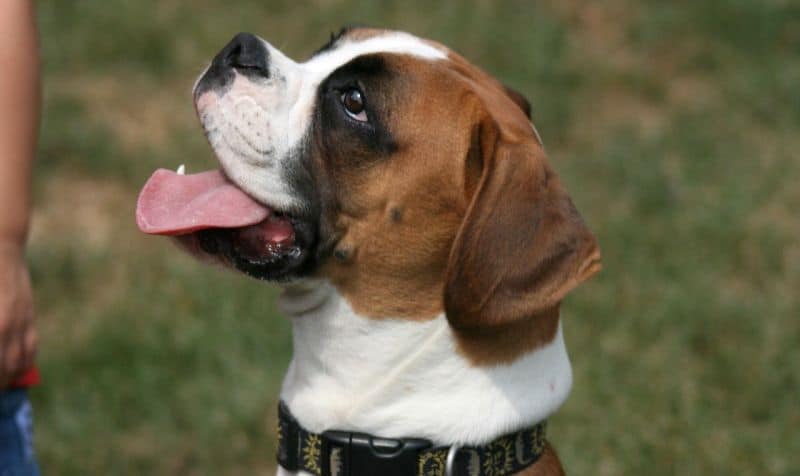
Most people see the boxer’s pout and assume he’s brachycephalic, but this isn’t always the case. In one 2016 study compiling the height, body weight, and cephalic index of various breeds, every measured boxer actually scored in the dolichocephalic range.
However, that doesn’t mean there aren’t brachycephalic boxers out there — clearly there are.
Feed your bouncing boxer right! Check out six of the best boxer dog foods!
2. Cane Corso
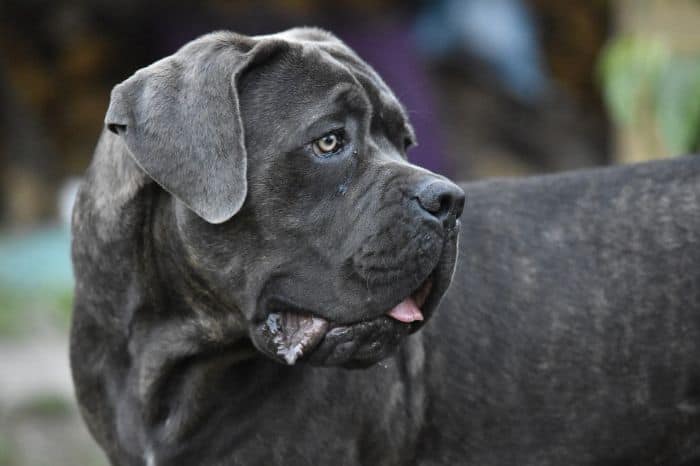
While some cane corsos fall within the brachycephalic range, not all do. The breed’s blocky head sees differing lengths depending on parentage.
He is prone to eye issues, however, particularly those relating to the eyelid. Also, because of his size and propensity for joint issues, it’s imperative that you select a good dog food for your cane corso.
3. Cavalier King Charles Spaniel
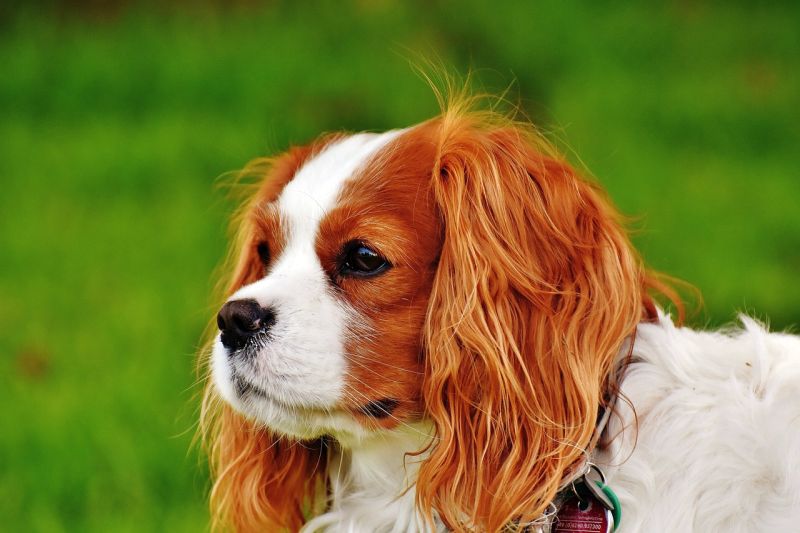
This sweet spaniel occasionally charts as brachycephalic, but the majority are mesocephalic. That doesn’t mean you shouldn’t pay close attention to a Cavy’s head, however, as the breed is prone to its fair share of health concerns pertaining to its shape, including eye issues, Chiari-like malformation, and syringomyelia.
The Cavalier is wonderful with kids and other dogs, earning him a spot in many households.
4. Chihuahua
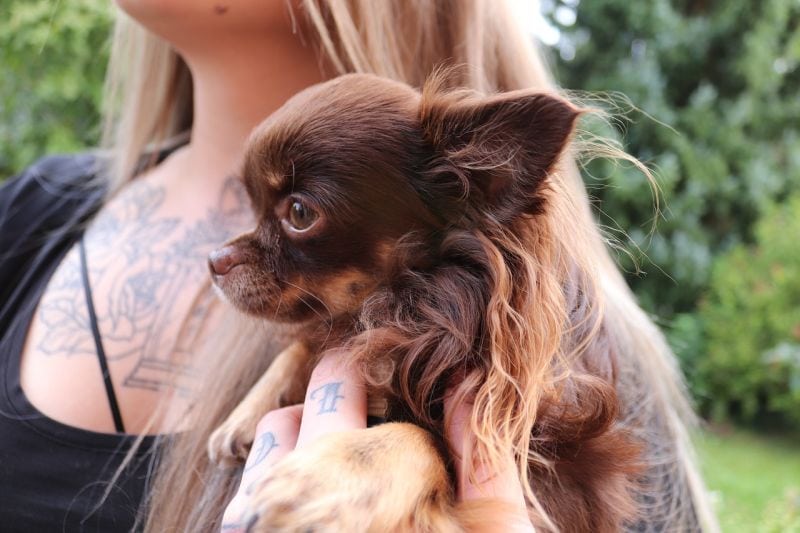
Chihuahuas are often labeled brachycephalic, though not all of these pocket pups score over 80 on the cephalic scale.
The apple-headed versus deer-headed Chihuahua factor is definitely at play here, with apple-headed Chis making up most of the brachycephalic breed examples. Most Chihuahuas are dolichocephalic.
5. Havanese
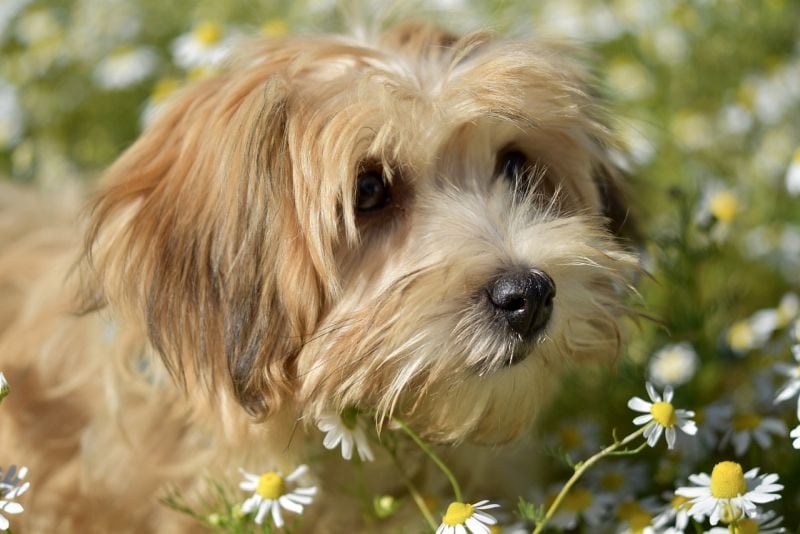
The occasional Havanese or Havanese mix is brachycephalic, but most are dolichocephalic, much to the relief of breed fanciers. Pressing health concerns for the breed include heart murmurs, eye issues, and patellar luxation (but you may be able to address some of these by picking a good Havanese dog food).
This breed’s playful and friendly nature works well in families with kids, and his eagerness to please makes training a breeze.
6. Mastiff

This larger-than-life doggo is often labeled brachycephalic despite not always meeting the cephalic index score necessary to fall into that category. In fact, most mastiffs are dolichocephalic.
This breed can experience eye issues along with heart and joint problems, so food choice is critical.
7. Neapolitan Mastiff
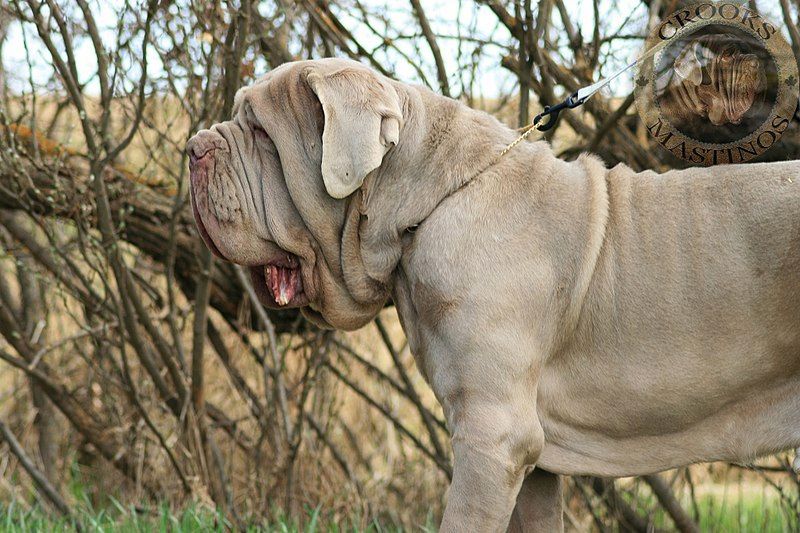
The Neo’s colossal head occasionally falls into the brachycephalic category, though many pups measure as mesocephalic or dolichocephalic.
Weighing above 100 pounds, this is one of the largest dog breeds (and also the record-holder for largest dog litter ever). The jowly gentleman is a big-time drooler who will coat your house in slobber, so neat freaks should look elsewhere.
8. Papillon
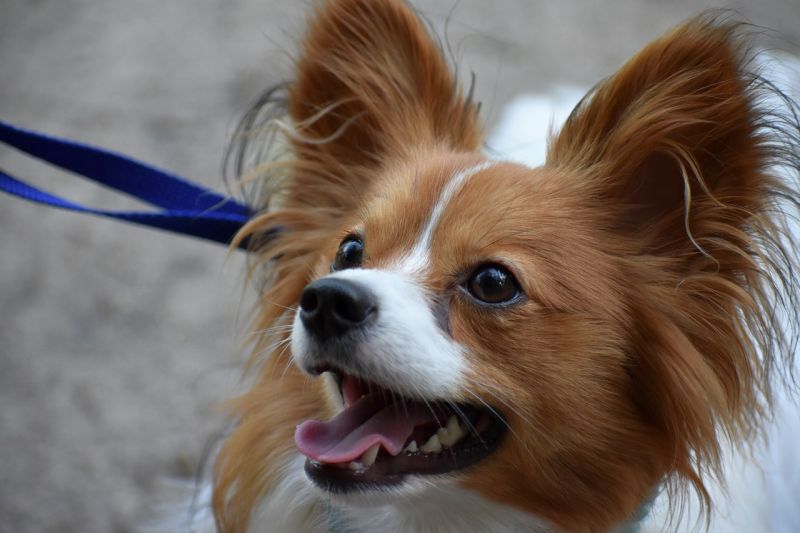
Most of these butterfly-eared barkers are dolichocephalic, but the occasional brachycephalic one occurs. He’s pretty healthy compared to other toy breeds, though slipping kneecaps and heart issues sometimes happen.
The Papillon is one of the smartest dog breeds and responds well to reward-based training.
9. Pomeranian
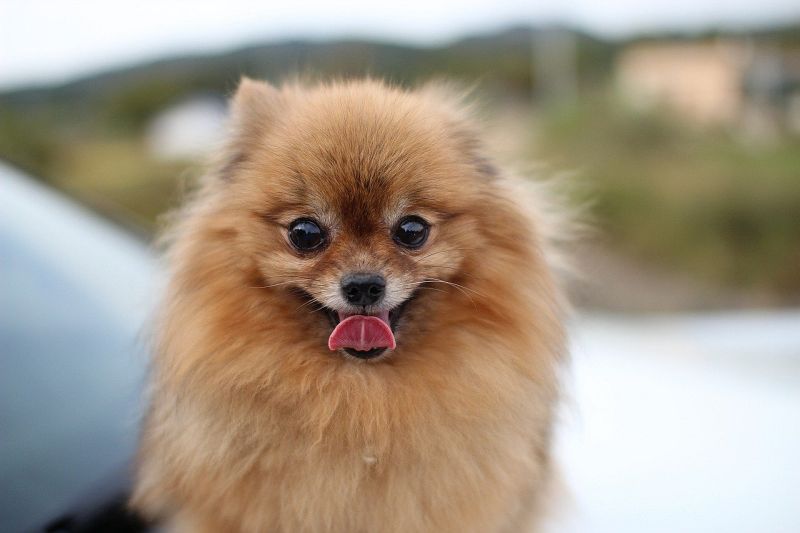
This saucy small breed can be brachycephalic, though many fall within mesocephalic parameters. Seek an ethical Pom breeder to avoid extremes in head shape or size, as the trend toward “pocket Poms” harms the breed’s health.
Other conditions to watch for are collapsing trachea, congestive heart failure, and luxating patella.
10. Shar Pei
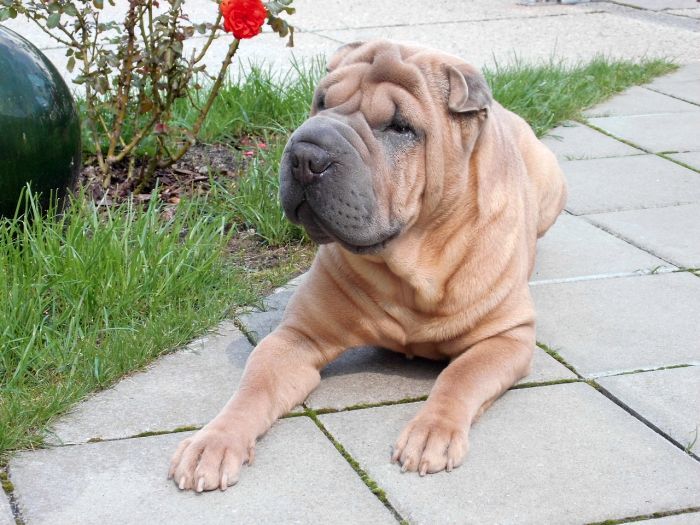
This wrinkly rover often fits the brachycephalic scoring range, while others are mesocephalic or dolichocephalic. Breathing issues are a concern with the brachycephalic doggos, but the breed’s unique look can also cause other issues, including eye and skin disorders.
He needs a fair amount of socialization, as he’s known for not being the biggest fan of other canines.
11. Staffordshire Bull Terrier
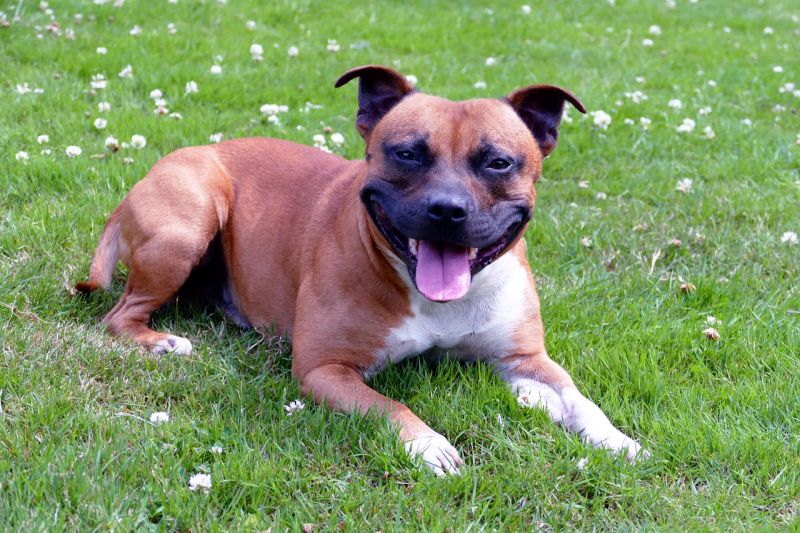
Also known as the “Staffy,” the Staffordshire bull terrier has some brachycephalic members in its ranks, but others score within the mesocephalic or dolichocephalic range. Brachycephalic Staffies should be handled with the appropriate care, but all Staffies are at-risk of other health issues like skin allergies and early-onset cataracts.
The Staffy isn’t recommended to newbie dog owners, as he can and will push boundaries.
5 Dog Breeds Commonly Listed as Brachycephalic, Which Usually Aren’t
A few breeds get labeled as brachycephalic that are real headscratchers, as pups within their ranks rarely have a cephalic index above 80. While you may have seen these sniffers called brachycephalic, they most often don’t fit the textbook definition unless intentionally bred for unnatural builds.
1. American Pit Bull Terrier
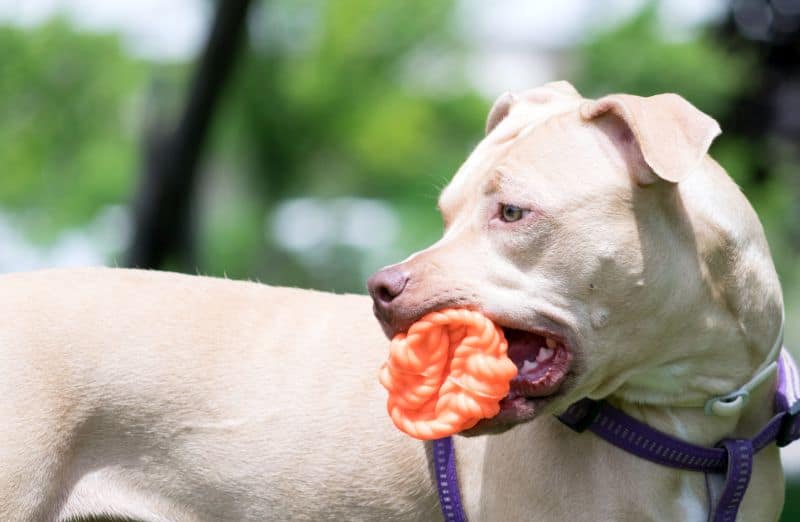
The UKC breed standard states “the head is of medium length” for the APBT, but that doesn’t mean the occasional brachycephalic pittie doesn’t exist. Unfortunately, not every breeder follows the standard, and with the rise of bully breed spin-offs (and the demand for them,) heads keep getting shorter and more extreme.
Allergies are another major problem found in these handsome pups.
2. American Staffordshire Bull Terrier
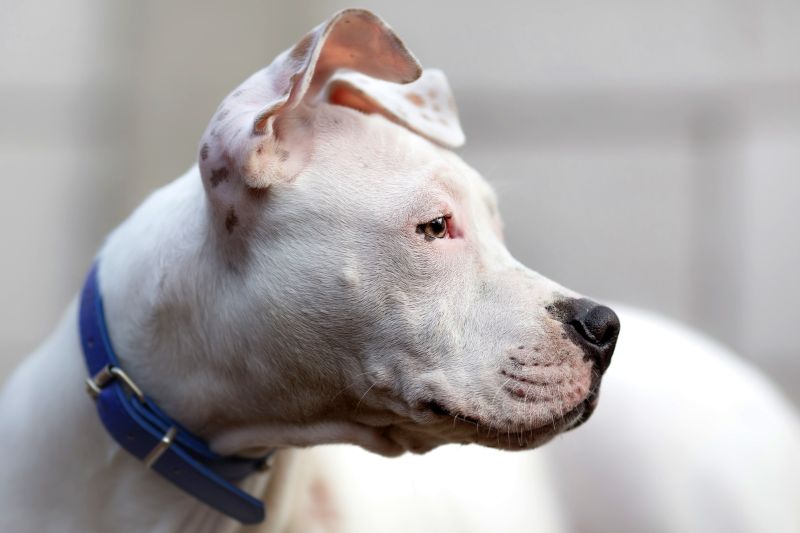
Unlike their English Staffy cousins, the American Staffordshire bull terrier doesn’t score as brachycephalic very often.
Most are dolichocephalic with much longer skulls and pronounced muzzles. This is a major plus since this canine athlete needs daily exercise.
3. Newfoundland
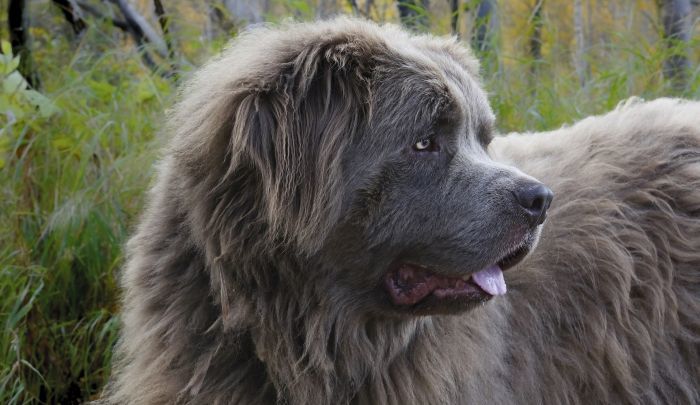
This northern working breed’s blocky head is sometimes categorized as brachycephalic, but most Newfs don’t fit the true definition. Unfortunately, shoddy breeding has shortened skulls in some lines, which deviate from the standard.
Watch for joint issues in your Newf, along with heart problems and bladder stones. A good dog food for Newfoundlands can help with the joint issues.
4. Rottweiler
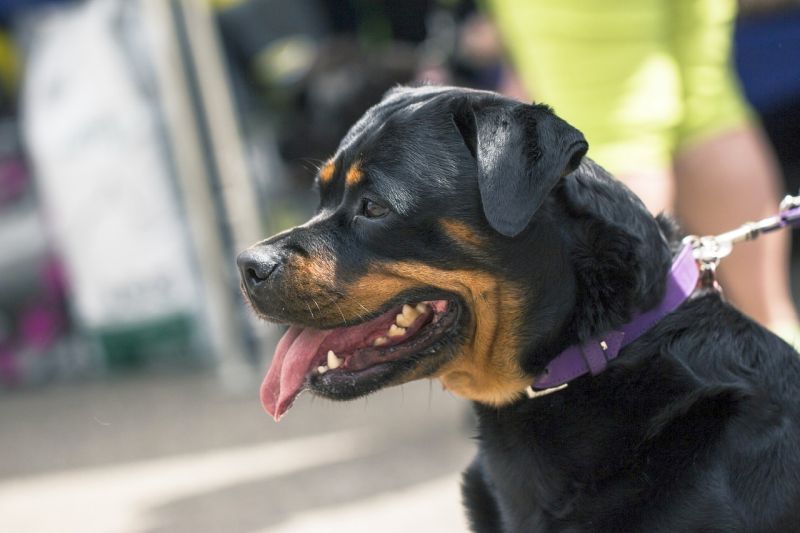
Some sites list the Rottweiler as brachycephalic, though most actually rank as dolichocephalic. There is an ongoing issue of poor breeding that can lead to body shape extremes, however, which might explain why Rotties are sometimes found to be brachycephalic.
Ongoing, positive training with your Rottie is recommended along with daily, breed-appropriate exercise.
5. Saint Bernard

This mouthy molosser is sometimes labeled as brachycephalic, but while his muzzle is broad and somewhat stout, it generally balances out with his head to land him in the dolichocephalic territory. That doesn’t mean he tolerates heat well, so keep him protected during summer and avoid excessive exercise outdoors.
Monitor his eyes for issues, too, since he’s susceptible to various diseases.
What Health Problems Affect Brachycephalic Dogs?
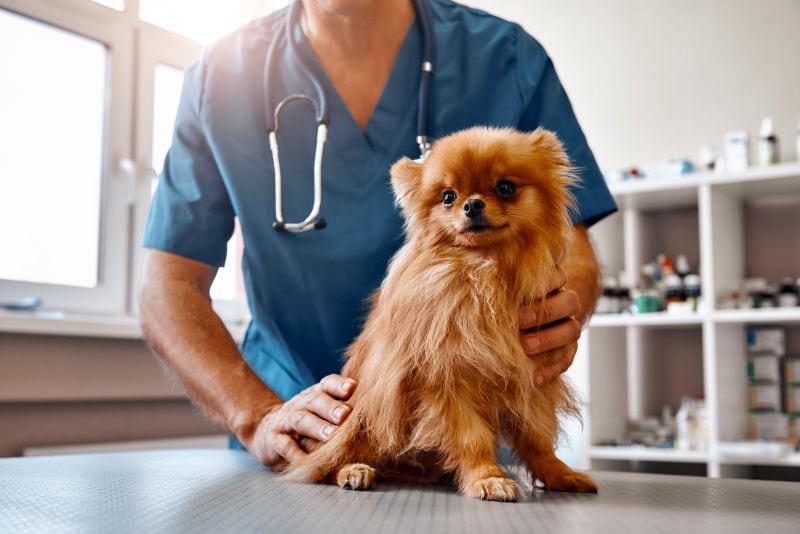
While short-faced pooches are cute with bug-eyed expressions and piggy noises, this extreme head shape poses major risks to your dog’s well-being.
Health issues related to brachycephaly in dogs include:
- Brachycephalic Airway Obstruction Syndrome: As explained above, the reduced length of a brachycephalic dog’s head crams too much in a small place, potentially causing airway blockage that makes breathing difficult, even at rest.
- Brachycephalic Ocular Syndrome: Dogs afflicted with this cannot properly close their eyelids, leading to dry eyes and possibly ocular ulcers.
- Hypoplastic trachea: This narrowing of the trachea limits airflow.
- Conjunctivitis: The bug-eyed look of brachycephalic dogs leaves their peepers at risk of infiltration and infection.
- Sleep apnea: Brachycephalic dogs may snore loudly or even stop breathing while sleeping due to airway difficulties.
- Recurring ear infections: Narrowed ear canals allow for easier buildup of bacteria.
- Narrowed nostrils: The smooshed muzzle of brachycephalic breeds often leads to distortions of facial features, including nostrils, worsening breathing issues.
- Enlarged laryngeal saccules: Found by the larynx, these sacs can be sucked into your dog’s airway, affecting his breathing.
- Laryngeal collapse: Ongoing stress to the larynx (voice box) through heavy breathing or exertion can damage your dog’s larynx to the point of collapse.
- Extended nasopharyngeal turbinates: An overgrowth of this tissue-covered bone found in the nasal area can obstruct your dog’s airway.
- Elongated palates: The roof of your dog’s mouth may partially cover the back of his throat, reducing his airway.
- Skin fold dermatitis: Brachycephalic dogs often have extra skin or wrinkles around the facial area that can trap moisture and debris, leading to skin irritation and infection.
- Dental crowding: Shortened jaws may lead to tooth crowding, leading to decay and tartar buildup being much more prevalent.
- Difficulty in birthing puppies: The broader heads of brachycephalic dogs often cause difficult labor, making cesarean sections far more common (and occasionally outright necessary).
Many of these conditions can be life-threatening or cause lifelong challenges to your dog. If you have a brachycephalic dog, ask your vet how to best meet his needs to keep him happy, healthy, and safe year-round.
Complications of Living With a Brachycephalic Breed

With the mile-long list of health issues associated with brachycephalic dog breeds, it’s no surprise that having one in your family may require adjustments compared to other breeds. These range from occasional tweaks in routine to daily challenges.
Temperature Concerns
Brachycephalic dogs are extremely sensitive to hot, humid, or cold weather.
While no pup should be outside in temperature extremes beyond a quick potty break, avoiding prolonged exposure to these weather conditions with your brachycephalic fur friend is critical. Not only will your pup struggle to breathe, but he may suffer life-threatening emergencies, such as heatstroke in high temperatures.
They aren’t a magic bullet for brachycephalic breeds, but cooling vests can help keep short-faced pups a little bit cooler in warm weather.
Caution With Exercise
Physical exertion is extra hard on a short-headed dog’s body, particularly if his airway is obstructed.
So, skip the high-octane play other dogs may enjoy for more short-face-friendly activities, like leisurely walking or indoor play with plenty of breaks. Keep the weather in mind, too, as high heat or humidity can make even a laidback stroll dangerous.
Brachycephalic breeds shouldn’t be allowed around water unattended, either. Many have shortened necks, which, paired with decreased stamina, mean swimming is far too risky. Others, such as the bulldog or pug, may have body shapes that are too extreme for swimming at all.
Flying Challenges
Most airlines have some form of a ban against brachycephalic dogs traveling via cargo. For many companies, this ban extends to the cabin, too, as brachycephalic dogs often can’t handle the rigors of air travel, including riding under an airline seat in a kennel.
Obviously, this can significantly impact your travel plans, though driving with your pooch or traveling via train is generally safe for these doggos.
Digestive Issues
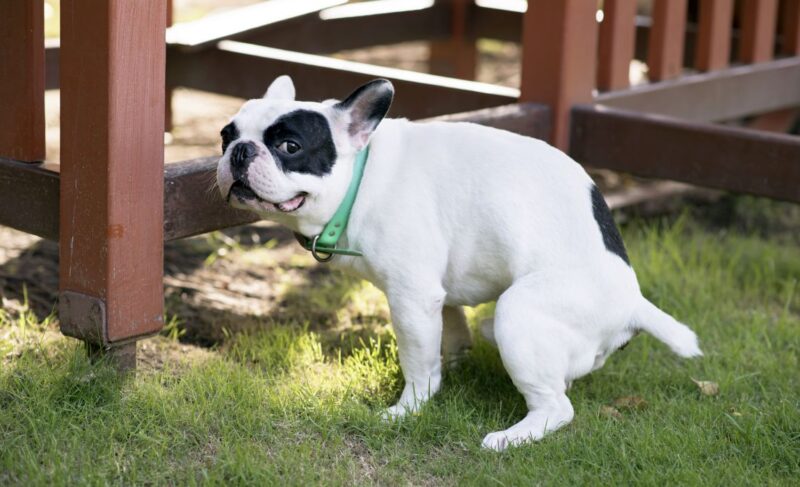
Brachycephalic dog breeds may swallow a lot of air while eating, leading to regurgitation. Gulping this excess air can lead to gassiness, too, so don’t be surprised if you hear a symphony of dog toots after mealtime.
Unfortunately, brachycephalic dogs can also gag on food or even develop aspiration pneumonia if they inhale food or water.
Vet Costs
Veterinary bills for brachycephalic dogs can easily extend into the thousands, depending on your dog’s condition. Special care is also needed around anesthesia and surgery, which can significantly affect your bank account.
You can control costs to an extent with canine health insurance, but premiums may be higher with such a high-risk breed.
Emotional Toll
It’s often overlooked, but seeing your dog struggle to breathe is emotionally draining. There’s also the constant worry of “what if” lurking that even the most experienced dog owners can’t shake.
What if your dog sneaks out of the yard on a hot day? What if your pup with sleep apnea stops breathing, and you aren’t there to rouse him? What if your bug-eyed buddy scratches his eye accidentally?
Canine health hiccups are hard enough to face once in a while, but with brachycephalic breeds often suffering lifelong issues, it can be downright devastating for you as a pup parent.
How to Keep Your Brachycephalic Breed Healthy
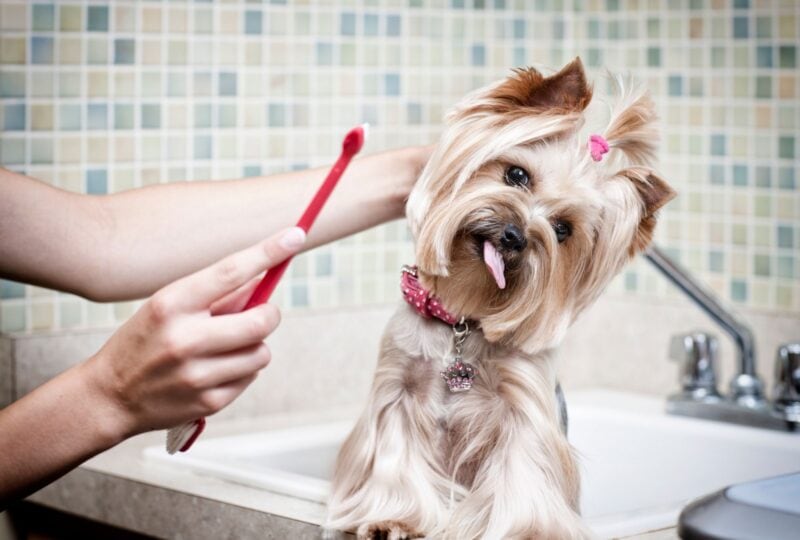
A little mutt maintenance goes a long way in helping your brachycephalic buddy feel his best. This might look like a lot, but it becomes second nature once you get into a routine.
Practice these good habits to boost your pup’s health:
- Maintain a normal weight. Obesity further strains your dog’s body and breathing. Keep a close eye on his four-footed figure to ensure he’s trim. That may mean reducing his portion sizes, limiting high-calorie treats, or sneaking in more steps every day under your vet’s guidance.
- Brush your dog’s teeth regularly. A solid brushing routine with a quality dog toothpaste is essential, along with offering tooth-safe chews.
- Clean facial folds. Squished faces with lots of wrinkles can harbor moisture and bacteria. Wipe them down as needed with a clean towel to prevent irritation.
- Monitor eye health. Clean away eye boogies daily with a clean, damp cloth, and watch out for signs of a problem, such as excessive blinking, squinting, or pawing at the eye.
- Clean your dog’s ears. Wipe your pup’s ears out regularly to prevent problems and pain. Be gentle, too!
- Keep up with regular veterinary exams. Your best defense against canine health issues is a good offense with preventative exams. It’s much easier (and cheaper) to spot a problem early on at an annual exam and treat it than deal with it at an emergency appointment. An annual checkup is recommended for most dogs, with twice yearly visits best for seniors.
- Address illness promptly. Upper respiratory infections can quickly become dangerous in brachycephalic breeds. Give your vet a call if you notice your dog coughing, wheezing, or sniffling.
- Avoid high-risk activities. No surprise here, but your brachycephalic breed shouldn’t be training for triathlons. He also shouldn’t run through brush that may poke at his eyes, suntan outside on a hundred-degree day, or go swimming in the sea.
- Chat with your vet. Your vet can discuss ways to help your dog breathe easier. For instance, surgery can sometimes help dogs suffering from BAOS by addressing structural abnormalities in the nose or throat.
You’d do many of these things with any floof, but they’re especially important with these delicate doggos.
Brachycephalic Dog Breeds FAQ
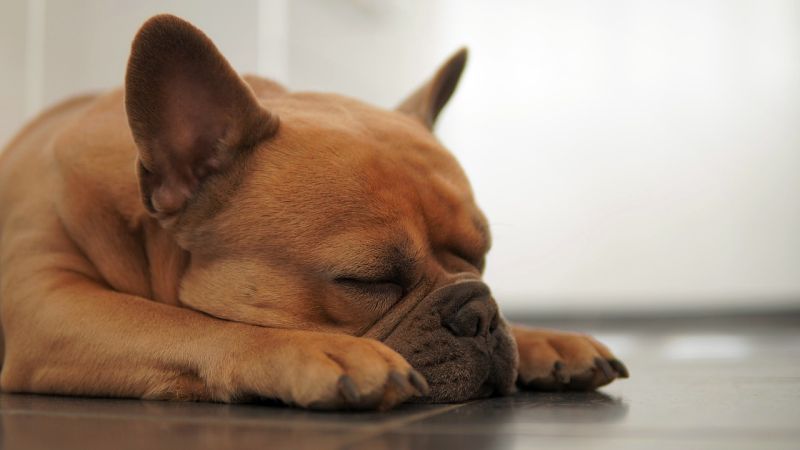
Brachycephaly is a complicated topic, so we wrangled the most commonly asked questions to break it down. Let’s learn a little more about these dogs together.
What are brachycephalic dog breeds?
In simple terms, brachycephalic means short-skulled. But a dog’s skull must exceed 80 on the cephalic index to be considered truly brachycephalic.
To calculate your dog’s cephalic index, take the maximum width of his head and multiply it by 100. Then, divide that total by the maximum length of his head.
A score of 80 or above is considered brachycephalic, while dogs scoring between 75 and 80 are mesocephalic. A total under 75 is known as dolichocephalic.
Do brachycephalic dogs suffer?
Unfortunately, yes, in most cases.
Some brachycephalic dogs may not have any breathing issues, but most struggle to breathe in situations where other dogs are fine. These dogs may not be able to play and enjoy life as much as other canines. Not only is struggling to breathe clearly uncomfortable, but it can be distressing to your dog.
Are pit bulls brachycephalic?
Some American pit bull terriers may be brachycephalic, but the UKC breed standard calls for a medium-length head, which by definition, is mesocephalic.
How can you tell if your dog is brachycephalic?
The easiest way is to calculate your dog’s cephalic index yourself. Measure his skull at the widest point and multiply that by 100. Divide the total by the length of his head at the longest point. If the answer is 80 or above, your dog is brachycephalic.
If you don’t have access to a tape measure, you can make a somewhat educated guess by looking at your dog’s head and considering his symptoms. Is his head broad and relatively short? Is his muzzle stubbier than most? Does he breathe loudly or snore? Does he tolerate the heat?
What are some brachycephalic dog symptoms?
Dogs with brachycephaly usually breathe louder than other canines. They also produce various other respiratory noises, including reverse sneezing, snuffling, snoring, and coughing.
Chances are, your vet has already discussed your dog’s brachycephalic status with you, but if they haven’t and you notice any of these signs in your dog, head in for an exam and discuss how you can improve your dog’s breathing.
What is brachycephalic dog syndrome?
Also known as brachycephalic airway obstruction syndrome (BAOS,) brachycephalic dog syndrome describes the compromised respiratory system of some short-headed dogs. Affected areas of the respiratory system can vary from dog to dog, with some suffering from nasal structural abnormalities while others might have issues with the throat or mouth.
What are the healthiest brachycephalic dog breeds?
Brachycephalic breeds aren’t exactly healthy as a whole, so picking the “healthiest” is a feat. Their extreme head shape is a gamble that’s hard to predict. On the flip side, it’s easy to pin down the least healthy, which is a three-way tie between the bulldog, French bulldog, and pug.
If you like the look of brachycephalic dogs but not the health concerns, see breeds that trend toward mesocephalic, like the Pomeranian, Chihuahua, or Staffordshire bull terrier. These pups are sometimes brachycephalic but often fall into the mesocephalic range.
Can you fly with brachycephalic dogs?
Maybe, but not usually. The majority of airlines have a ban on brachycephalic breeds for cargo travel, though now many refuse cabin travel for them as well.
This may feel unfair, but it’s honestly in your dog’s best interest to stay on the ground, as brachycephalic dogs usually already suffer from respiratory distress. The reduced airflow in cargo areas or under-seat storage can have disastrous results. Not to mention that travel stress can be too much on their delicate systems.
***
Brachycephalic breeds are loaded with character, but the trademark look has serious drawbacks. The good news is that many brachycephalic breed enthusiasts are investigating ways to produce healthier dogs that can breathe easier in the future.
Do you have a brachycephalic breed at home? How do you meet his needs? Any tips or tricks for other pet parents with brachy breeds?
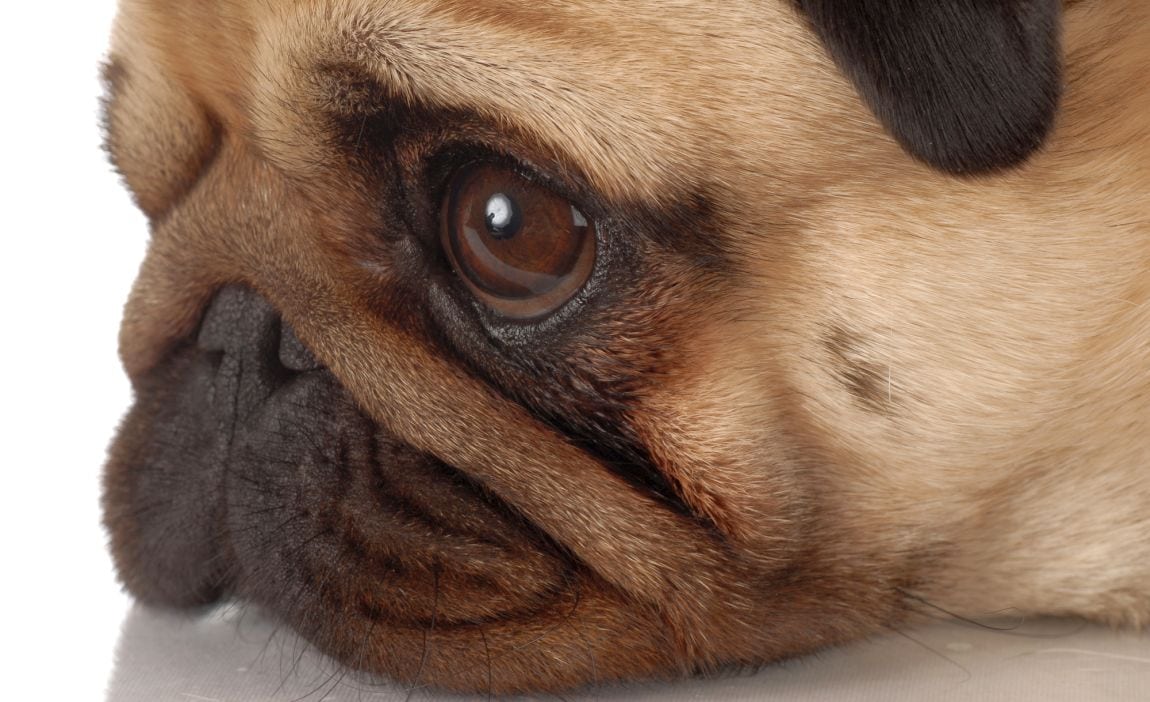

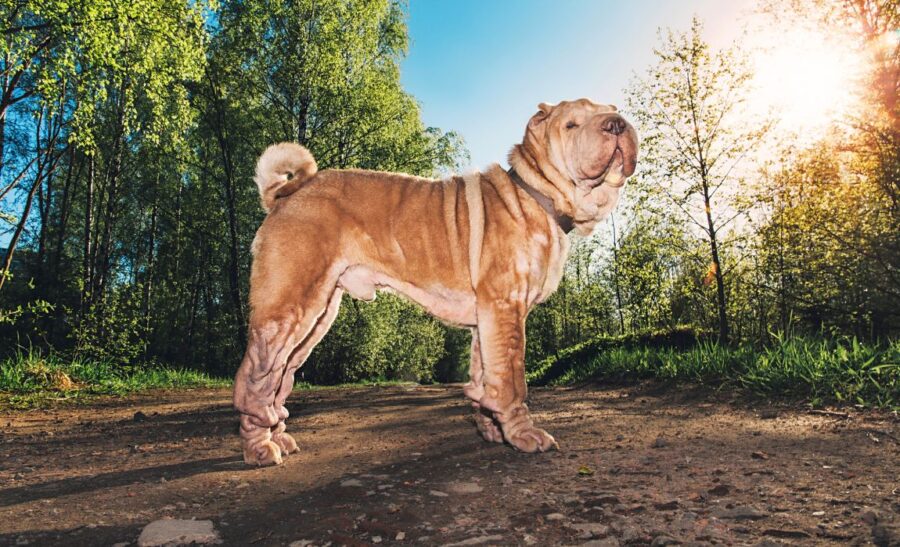


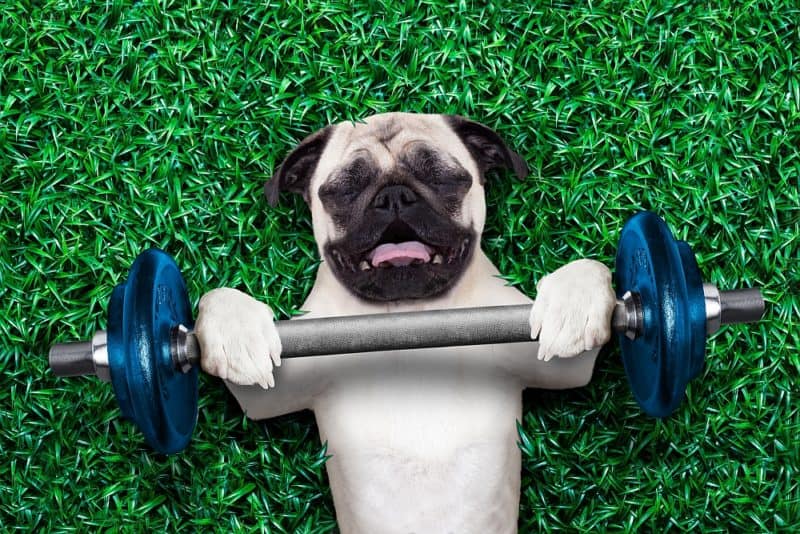
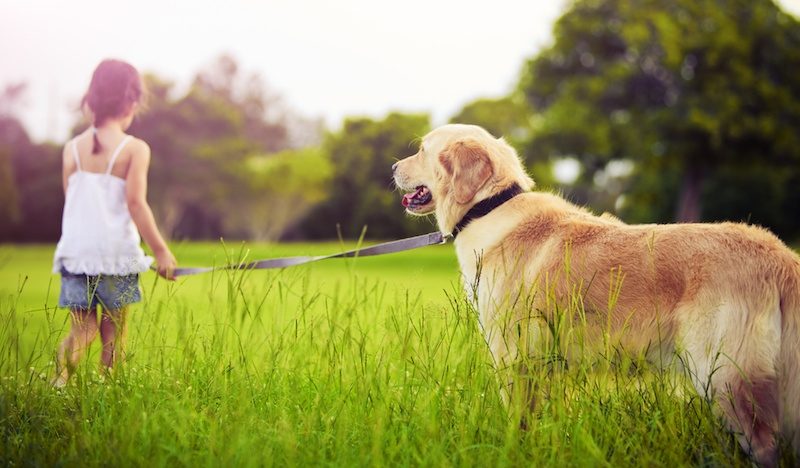
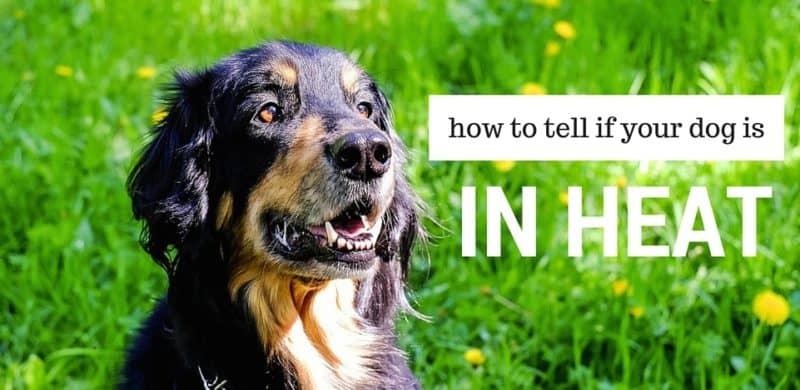

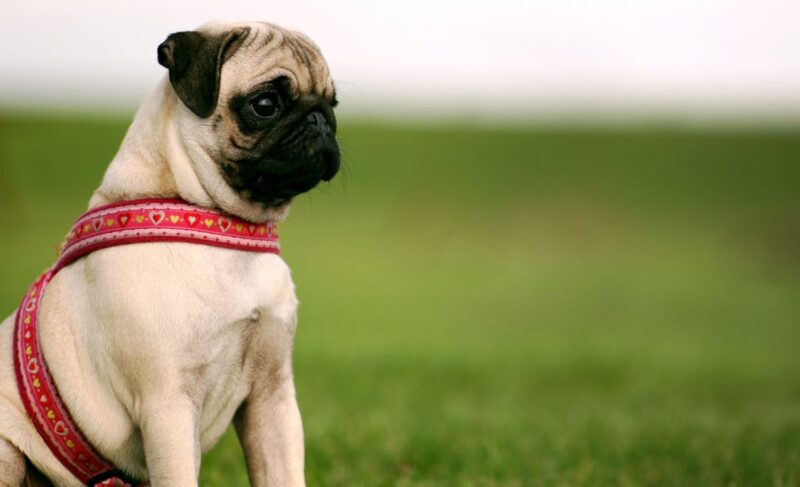
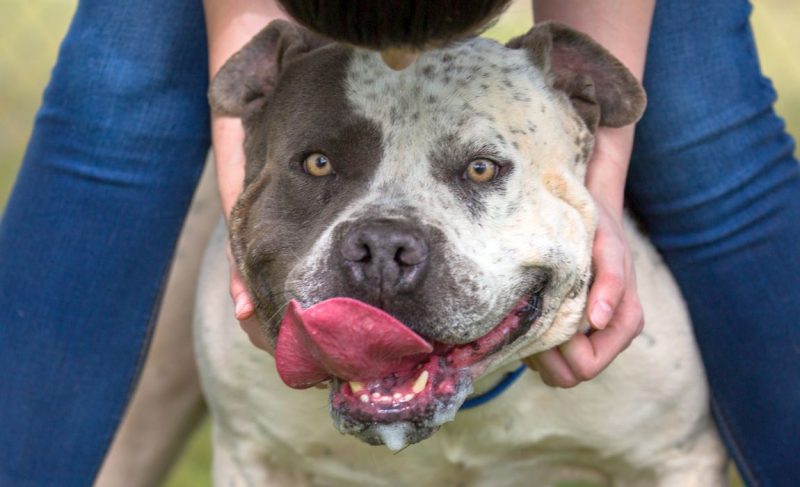
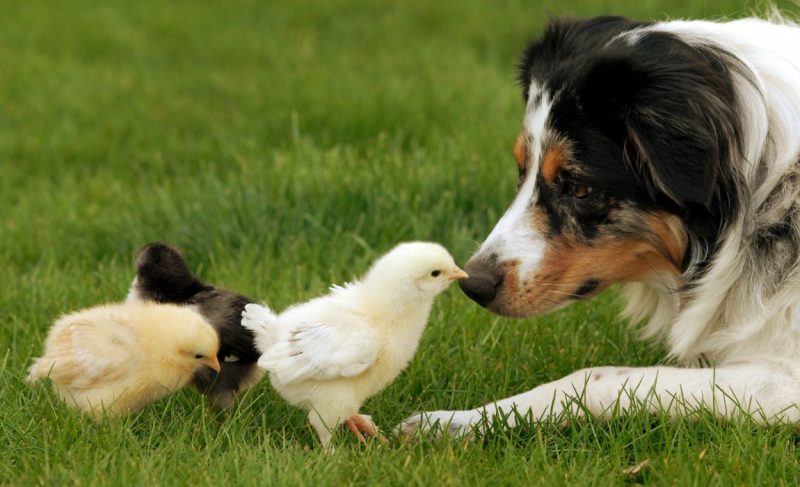

Leave a Comment